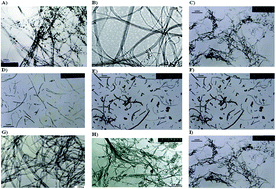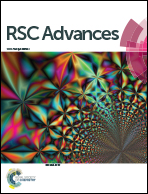Mitoprotective activity of oxidized carbon nanotubes against mitochondrial swelling induced in multiple experimental conditions and predictions with new expected-value perturbation theory†
Abstract
Mitochondrial Permeability Transition Pore (MPTP) is involved in neurodegeneration, hepatotoxicity, cardiac necrosis, nervous and muscular dystrophies. We used different experimental protocols to determine the mitoprotective activity (%P) of different carbon nanotubes (CNT) against mitochondrial swelling in multiple boundary conditions (bj). The experimental boundary conditions explored included different sub-sets of combinations of the following factors b0 = three different mitochondrial swelling assays using the MPT-inductor (Ca2+, Fe3+, H2O2) combined or not with a second MPT-inductor and swelling control assays using MPT-inhibitor (CsA, RR, EGTA), b1 = exposure time (0–600 s), and b2 = CNT concentrations (0–5 μg ml−1). Other boundary conditions (bk) changed were the CNT structural parameters b3 = CNT type (SW, SW + DW, MW), b4 = CNT functionalization type (H, OH, COOH). We also changed different of CNT like b5 = molecular weight/functionalization ratio (minW/maxW) or b6 = maximal and minimal diameter (Dmin/Dmax) as physic-chemical properties (Vk). Next, we employed chemoinformatics ideas to develop a new Perturbation Theory (PT) model able to predict the %P of CNT in multiple experimental conditions. We investigated different output functions of the absorbance ′f(εij) used in PL4/PL5 methods like (εij, 1/εij, 1/εij2, or −log εij) as alternative outputs of the model. The inputs are in the form an additive functions with linear/non-linear terms. The first term is a function 0f(〈εij〉) of the average absorbance 〈εij〉 (expected value) in different assays (bj). The concentration dependent terms are linear functions of concentration, or hill-shaped curves similar to PL4/PL5 functions (used in dose–response analysis). The CNT structure perturbation terms are linear/non-linear functions of Box–Jenkins operators (ΔVkj). The ΔVkj are moving averages (deviations) of the Vk of the CNT with respect to their expected values 〈Vkj〉. The best model found predicted the values of absorbance (measure of mitoprotective activity vs. mitochondrial swelling) with regression coefficient R2 = 0.997 for >6000 experimental data points (q2 = 0.994). Last, we used the model to carry out a simulation of the changes on mitoprotective activity for CNT family after one increase of 1–10% of the minWi and maxDi of CNT.



 Please wait while we load your content...
Please wait while we load your content...